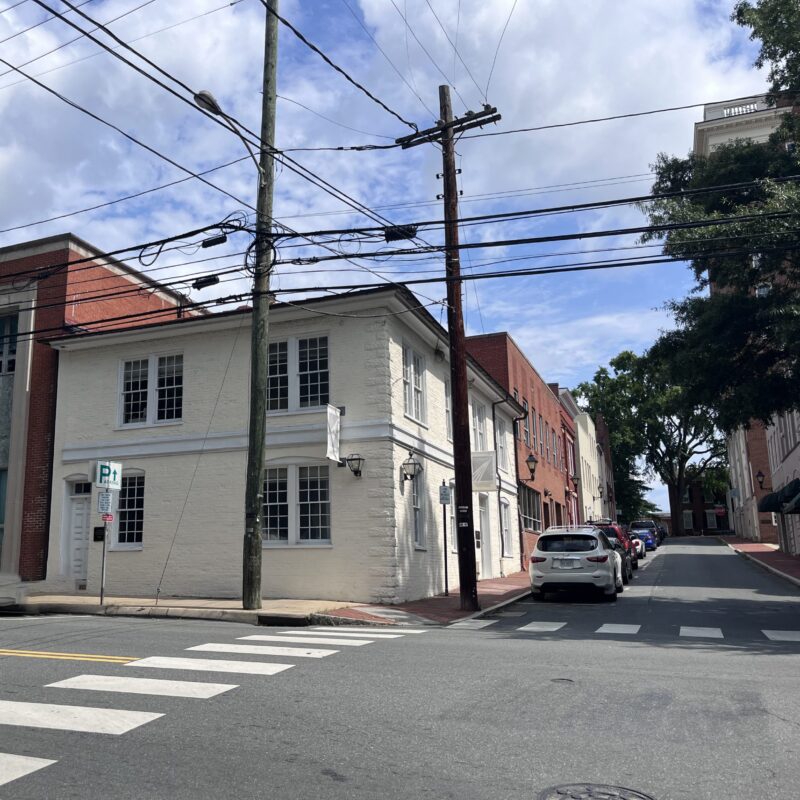“It is a great art to saunter” – Henry David Thoreau, Journal, April 26, 1841.
What a great place to take a walk! Blessed with an abundance of natural beauty, Central Virginia is flush with parks, trails and wilderness areas that beckon fitness buffs and nature lovers of all ages and experience levels, from families out for a stroll to experienced hikers eager for new sights and fresh challenges.
One way to get to know the region’s many hiking areas is through the Charlottesville chapter of the Potomac Appalachian Trail Club (PATC). Club president Iva Gillet came here in 1981 to attend the University of Virginia and stayed for the area’s natural beauty, but it wasn’t until after a divorce in 2002 that she actually took up hiking: “I didn’t know what to do with myself because I didn’t have children,” she says today. “The PATC had these hikes; I started with five mile hikes and worked my way up. Then they said, ‘Do you want to lead hikes?’ and I said, ‘Ah, OK, I can try that.” I just love it. I really, really love the Blue Ridge Mountains.”
There is no better place to explore than the 75-mile long Shenandoah National Park with its 93,000 acres of designated wilderness crowned by Blue Ridge Mountain peaks that are over 400 million years old and were once some of the highest on Earth. On clear days, some overlooks afford views as far as from Washington, D.C. and West Virginia. “We like the hikes with high summits and really good views, and also wonderful waterfall hikes,” Gillet says, and who doesn’t? A wilderness walk can be a tonic for the soul – but so can a stroll through one of our many city and county parks.
Saunders-Monticello Trail
Visitors to Thomas Jefferson’s Monticello have always enjoyed the short trek through the woods that leads from the South Lawn to the great man’s gravesite. In 2000 the Thomas Jefferson Foundation opened the Saunders-Monticello Trail, a relatively easy, 4.6 mile roundtrip trail open year-round and accessible from the parking lot just off Route 53. The scenic trail winds through Kemper Park with its arboretum of native trees and shrubs, over elevated boardwalks, and up the side of Carter Mountain past an overlook toward Monticello. A handsome stone-arch bridge leads to the Monticello ticket office. With a maximum grade of only five percent, this trail attracts cyclists as well as walkers, and is accessible to people in wheelchairs.
Ivy Creek, Old Mills Trail, Rivanna Trail and Mint Springs
The 215-acre Ivy Creek Natural Area borders the South Fork Rivanna Reservoir and boasts more than seven miles of walking trails through upland woods and pine stands, across fields and streams, and along two miles of shoreline. In hiker lingo, these trails have “little elevation change.” Translation: The landscape is pretty flat. No dogs, no jogging, no hunting and no collecting specimens allowed.
Elsewhere in Albemarle County, the three-mile long, wheelchair accessible Old Mills Trail runs along the Rivanna River between Charlottesville’s Darden Towe Park and Martha Jefferson Hospital. The Rivanna Trail’s footpaths and greenways circumnavigate Charlottesville’s city limits, running in part along the western bank of the Rivanna River. The 520-acre Mint Springs Valley Park has three trails, 1.8 mile, .8 and .5 miles in length. Near to civilization as they are, these city and county parks are fine spots to enjoy fresh air, flora, and fauna, all the while – striding or sauntering – gradually working oneself into shape for the wilderness.
Dark Hollow and Rose River Falls
Legend has it that Thomas Jefferson loved Dark Hollow Falls. True or not, the 1.4 mile roundtrip trail that descends 440 feet from Skyline Drive just north of the Big Meadows campground is one of the most popular trails in Shenandoah Park today. Just be prepared for the steep uphill return hike. “Dark Hollow is beautiful – you can see it from the top and then you can hike down and see it from the bottom,” Gillet says. “You walk a very short distance and you’re at the top of a stream that leads to a really awesome waterfall. The PATC often does a five-six mile loop trail where you get two waterfalls, Rose River Falls and then Dark Hollow Falls.” At only 67 feet, Rose River Falls is small but picturesque, cascading as it does down a series of rocks.
Old Rag Mountain
With panoramic views, a challenging rock scramble, and a quick trip through a small cave, Old Rag Mountain loop is the most popular hike in the Shenandoah National Park and perhaps the entire mid-Atlantic region, attracting both casual and serious hikers. Getting up and down the 2,510 foot mountain takes about five and a half hours, with a half hour included for lunch. The steep rock scramble isn’t easy, and requires climbing through cracks in the rock. Expect to engage in hand over hand climbing at some points, and to hop over many rocks in the last 1/3 of a mile to the summit. Also expect to feel sore the next day. No dogs allowed.
Old Rag Loop is “head and shoulders above any other trail within a two hour drive of Charlottesville,” says Chicago area native Jeff Monroe. Monroe should know. He moved here 22 years ago, fell in love with the mountains, and now leads hikes for the PATC, the Roanoke Appalachian Trail Club, and Scout Troop 1028. “My son is 15 – he doesn’t really like to go hiking because it’s something that his Dad does all the time, but that’s the one hike that he always comes back to and says, ‘let’s do that one again.’”
But Old Rag is not for the reckless or the unprepared. “It’s tough trail,” Monroe says. “Last time I was there, a helicopter pulled a hiker off the summit after he suffered a broken leg.” And he cautions that Old Rag’s popularity makes it a busy place at the height of the season. “Personally, that’s my favorite, but I like to go on a weekday,” he says. “If you go on a Saturday in late October, when the leaves are changing, you will be there with literally thousands of other people because it’s the go-to spot for everyone from Washington, D.C. who goes on one hike a year.” No dogs.
Hawksbill Summit
The 2.9 mile trail up to Hawksbill Summit leads to the highest peak in Shenandoah National Park at 4,049 feet, and “it gives you at least a 270 degree view,” Gillet says. “It has a stone area kind of patio with a wall around it. It’s right beside Old Rag, so the view to the East is Old Rag, and into the west the Shenandoah Valley. Last August we hiked up and watched to sun set on one side and the moon rise on the other. It was just stunning.” The three-sided Byrd’s Nest Day Shelter offers a place to rest near the summit.
Riprap Trail
Riprap Trail is a moderately difficult 9.1 mile loop in the Shenandoah National Park that connects with the Appalachian Trail. From the parking area off of Skyline Drive, hikers turn onto Wildcat Ridge Trail and begin a gentle, 1500 foot-descent into Cold Stream Hollow. Winding through woods alongside a stream, the trail passes a 20-foot waterfall and a tall sandstone outcrop called Chimney Rock, before reaching Calvary Rock, the summit of Rocks Mountain. There are five stream crossings along the way.
Dogs are allowed. “I took Cub Scouts there a few years go,” Monroe remembers, “and the kids loved it. You walk through the woods for about a mile and a half and there is a little area where you can wade into the water.”
Humpback Rock
Wagon trains navigating through the Blue Ridge in the 1840s knew to be on the lookout for Humpback Rock, a huge greenstone outcrop near the peak of Humpback Mountain. While a portion of that historic Howardsville Turnpike still exists, hikers today can find Humpback six miles south of Interstate 64 near the northern part of the Blue Ridge Parkway. The trail up the rock attracts folks looking for a challenge – it rises just 740 vertical feet, but takes just a mile to do it. “It’s a hard half hour hike up to the top, but the view is just spectacular,” Monroe says. “That’s one of the first hikes that I did when I moved here 22 years ago, and I still do it all the time.”
The 360 degree view at the 3,080 feet summit encompasses Shenandoah National Park to the north, neighboring farms to the east, Shenandoah Valley to the west, and woods and mountain ridges of the George Washington National Forest to the southwest. The nearby, mile-long Mountain Farm Trail, accessible through the parking lot at the Visitor Center, winds through a recreated 1890s farm with a single-room log cabin and outbuildings typical of the late nineteenth century.
Fortune’s Cove
Just north of Lovingston in Nelson County is a 755-acre preserve situated within a 29,000 acre forest. Within the Cove is a 5.5-mile loop trail that includes several stream crossings, climbs 1,500 feet up to High Top Mountain, and takes even the hardiest of hikers about four hours to complete. The Fortune’s Cove trail is “a lovely but hard, five mile circle with substantial climbing in it,” Gillet says. “One section is super steep, so it’s not for everyone.” Still, “the views are stunning. A hurricane washed away a whole town in that area and you can look down on it from the northern loop of that trail. There is also radio tower you can go up to that has pretty incredible views.”
Crabtree Falls and Spy Rock
Dropping 1200 feet in just a half a mile, spectacular Crabtree Falls in the George Washington National Forest in Nelson County is the highest waterfall in the state and one of the highest east of the Mississippi. Actually, Crabtree is a series of falls, five major and several minor, on Crabtree Creek, which flows into the Tye River. The tallest of these individual falls drops 400 feet. “Crabtree Falls is a great one assuming that you follow the directions,” Monroe says. “We get a notice in the paper every year about somebody that wanders off and slips. You have to be careful and stay on the trail.”
A few miles up route 56 near Montebello is Spy Rock, a massive boulder overlooking lower Albemarle and Nelson County, said to have been a Confederate lookout during in the Civil War. The steep and rocky mile and a half long trail begins at a fish hatchery, rises 1260 feet, and includes a short scramble up a rock face, but offers panoramic views from the top. “It’s a 360 degree view from there,” Monroe says. “It looks out over a great, vast area of the national forest and it’s really a beautiful view.”
***
By Ken Wilson





